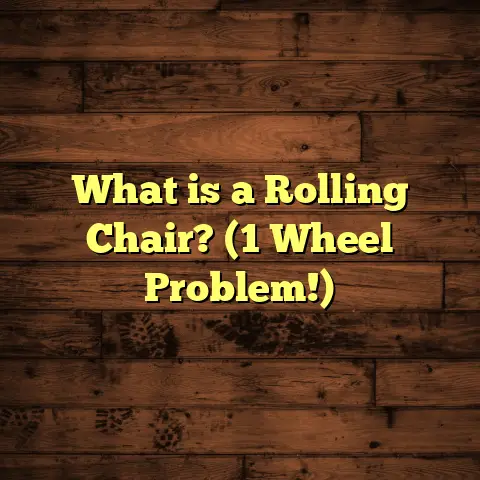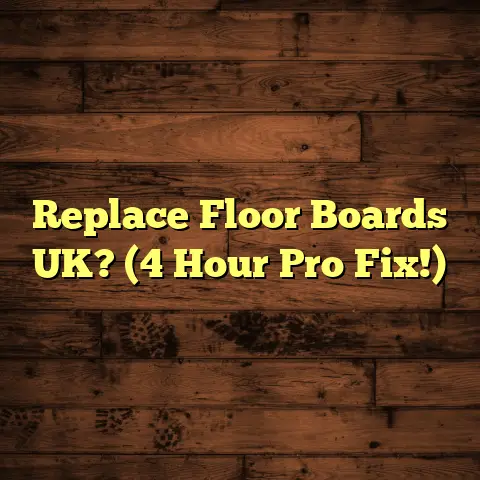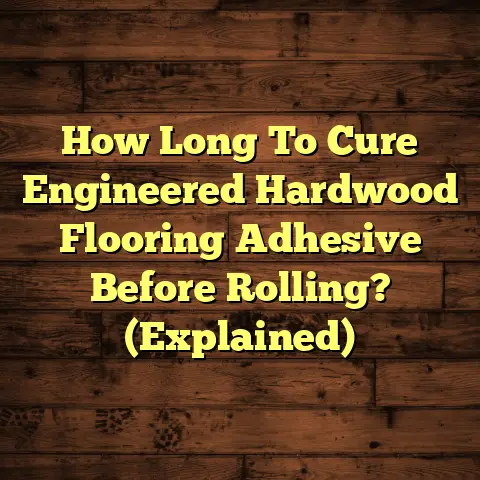How To Wash Vinyl Floors?
A Comprehensive Guide on How to Wash Them
Vinyl flooring – it’s been a staple in homes and businesses for decades, right?
And for good reason!
It’s durable, affordable, and comes in a zillion styles. I’ve installed countless vinyl floors over the years, and I’ve seen firsthand how a well- maintained vinyl floor can truly transform a space.
But let’s be real: even the toughest vinyl needs a little TLC. That’s where proper washing techniques come in.
Think of it this way: you wouldn’t neglect washing your car, would you? Same goes for your floors!
By following the right steps, you can keep your vinyl looking fantastic for years to come.
And that’s exactly what I’m here to help you with. Let’s dive into the world of vinyl floor care!
Section 1: Understanding Vinyl Flooring
So, what exactly is vinyl flooring?
Well, at its core, it’s a synthetic flooring made from polyvinyl chloride (PVC) and other compounds. It comes in a few different forms:
-
Sheet Vinyl: This comes in large rolls, making it great for areas like bathrooms and kitchens where you want minimal seams.
-
Vinyl Tiles: These are individual squares, offering more design flexibility.
-
Luxury Vinyl Plank (LVP): LVP mimics the look of hardwood, but with the added benefits of vinyl (water resistance, durability).
Why is vinyl so popular?
Let me tell you, there are tons of reasons!
-
Water Resistance: This is a big one. Unlike hardwood, vinyl can handle spills and moisture without warping or damage.
-
Easy Installation: Many vinyl options, especially LVP, are designed for DIY installation. I’ve seen homeowners transform rooms in a weekend!
-
Comfort Underfoot: Vinyl has a bit of give, making it more comfortable to walk on than tile or concrete.
-
Affordability: Compared to hardwood or stone, vinyl is a budget-friendly option.
Now, let’s talk about finishes. Vinyl floors come with different surface treatments, and this impacts how you clean them.
Some have a urethane coating for extra protection, while others might have a no-wax finish.
Knowing your floor’s finish is crucial for choosing the right cleaning products and methods.
Pro Tip: If you’re not sure what type of finish your vinyl floor has, check the manufacturer’s website or contact the retailer where you purchased it.
Section 2: Importance of Regular Cleaning
Okay, so you’ve got your beautiful vinyl floors installed. Now what?
Well, regular cleaning is absolutely essential.
Think of your floors as a magnet for dirt, dust, and grime. Over time, this buildup can dull the finish and even cause scratches.
Ever notice how a neglected floor looks kinda…blah? That’s the dirt talking!
Why is regular cleaning so important?
-
Prevents Dirt Buildup: Dirt acts like sandpaper, wearing down the surface of your vinyl.
-
Reduces Scratches: Embedded dirt can cause scratches and scuffs, especially in high-traffic areas.
-
Maintains Sheen: Regular cleaning keeps your floors looking shiny and new.
-
Extends Lifespan: By preventing damage, you can significantly extend the life of your vinyl flooring.
But here’s the thing: improper cleaning can actually do more harm than good.
Using abrasive cleaners or scrub brushes can scratch the surface, while harsh chemicals can damage the finish.
I’ve seen floors ruined by well-intentioned homeowners using the wrong products!
That’s why it’s crucial to use the right techniques and cleaning solutions.
Routine Maintenance vs. Deep Cleaning
There’s a difference between routine maintenance and deep cleaning.
-
Routine Maintenance: This involves regular sweeping or vacuuming, followed by a light mopping with a mild cleaner. Aim for this at least once a week.
-
Deep Cleaning: This is a more thorough cleaning that removes stubborn stains and grime. You might do this every few months.
Think of it like this: routine maintenance is like brushing your teeth, while deep cleaning is like going to the dentist. Both are important for keeping things healthy!
Section 3: Tools and Supplies Needed
Alright, let’s get down to the nitty-gritty.
What do you actually need to wash your vinyl floors?
Here’s a list of essential tools and supplies:
-
Broom or Vacuum Cleaner: For removing loose dirt and debris. A vacuum with a hard floor attachment is ideal.
-
Mop: A microfiber mop is your best friend. Avoid sponge mops, as they can leave streaks.
-
Microfiber Cloths: For wiping up spills and drying the floor.
-
Buckets: You’ll need at least two: one for clean water and one for your cleaning solution.
-
Cleaning Solution: Choose a pH-neutral cleaner specifically designed for vinyl floors.
Important: Avoid abrasive cleaners, bleach, and ammonia. These can damage the finish.
What to Look for in Cleaning Products
When choosing a cleaning product, keep these things in mind:
-
pH Balance: Opt for a pH-neutral cleaner (around 7).
-
Non-Abrasive: Avoid anything that contains abrasive particles.
-
Specifically for Vinyl: Look for products that are specifically formulated for vinyl floors.
DIY Cleaning Solutions
If you’re on a budget or prefer natural cleaners, you can make your own DIY solutions.
Here are a couple of options:
-
Vinegar and Water: Mix 1/2 cup of white vinegar with a gallon of warm water. Vinegar is a natural disinfectant and helps remove grime.
-
Dish Soap and Water: Use a few drops of mild dish soap in a gallon of warm water.
Caution: Always test any cleaning solution in an inconspicuous area first to make sure it doesn’t damage the floor.
Section 4: Step-by-Step Guide to Washing Vinyl Floors
Okay, now for the main event: actually washing your vinyl floors!
Follow these steps for a sparkling clean result:
Step 1: Preparation
-
Clear the Area: Remove any furniture, rugs, or other obstacles from the area you’re going to clean.
-
Gather Your Tools: Make sure you have everything you need within reach: broom, vacuum, mop, buckets, cleaning solution, and microfiber cloths.
Step 2: Dusting and Sweeping
- Remove Loose Dirt: Use a broom or vacuum cleaner to remove any loose dirt, dust, and debris from the floor. Pay attention to corners and edges.
Step 3: Washing
-
Mix Cleaning Solution: In one bucket, mix your chosen cleaning solution with warm water, following the manufacturer’s instructions (or the DIY recipe).
-
Mop the Floor: Dip your mop into the cleaning solution, wring it out thoroughly, and mop the floor in overlapping strokes. Work in small sections.
Pro Tip: Don’t over-saturate the floor. You want it damp, not soaking wet.
Step 4: Rinsing
-
Rinse with Clean Water: In the second bucket, fill it with clean, warm water. Use a clean mop to rinse the floor, removing any soap residue.
Why is rinsing important? Soap residue can attract dirt and leave a dull film on your floor.
Step 5: Drying
-
Dry the Floor: Use a clean, dry microfiber cloth to dry the floor. This will prevent streaks and water spots.
Speed up drying: You can also use a fan to help the floor dry faster.
Handling Stubborn Stains
Sometimes, you’ll encounter stubborn stains that require extra attention.
Here are a few tips:
-
Identify the Stain: Different stains require different treatments. Is it grease, ink, or food?
-
Spot Clean: Use a specialized stain remover or a paste of baking soda and water to spot clean the stain.
-
Gentle Scrubbing: Use a soft-bristled brush or a microfiber cloth to gently scrub the stain.
Important: Always test any stain remover in an inconspicuous area first.
Dealing with Scuff Marks
Scuff marks are a common issue on vinyl floors.
Try these methods to remove them:
-
Pencil Eraser: A simple pencil eraser can often remove scuff marks.
-
Baking Soda Paste: Make a paste of baking soda and water and gently rub it on the scuff mark.
-
Tennis Ball: Believe it or not, a tennis ball can also remove scuff marks. Just rub it over the mark.
Section 5: Tips for Maintaining Vinyl Floors
Washing your vinyl floors is important, but so is preventative maintenance.
Here are some tips to keep your floors looking their best:
-
Use Mats: Place mats at entrances to trap dirt and debris before they get onto your floors.
-
Avoid Harsh Chemicals: Stick to pH-neutral cleaners specifically designed for vinyl.
-
Trim Pet Nails: Long pet nails can scratch vinyl floors.
-
Use Furniture Pads: Place felt pads under furniture legs to prevent scratches and dents.
-
Avoid Dragging Furniture: When moving furniture, lift it instead of dragging it.
Immediate Cleanup for Spills
Spills happen, but prompt action can prevent staining and warping.
-
Wipe Up Spills Immediately: Use a clean microfiber cloth to wipe up spills as soon as they occur.
-
Blot, Don’t Rub: Blot the spill to avoid spreading it.
-
Use a Damp Cloth: If the spill is sticky, use a damp cloth to wipe it up.
Protecting from Heavy Furniture
Heavy furniture can leave dents and impressions on vinyl floors.
-
Use Furniture Pads: As mentioned earlier, felt pads are essential.
-
Distribute Weight: Use furniture coasters to distribute the weight of heavy items.
Section 6: Common Mistakes to Avoid
Even with the best intentions, it’s easy to make mistakes when cleaning vinyl floors.
Here are some common pitfalls to avoid:
-
Using Abrasive Tools: Avoid scrub brushes, steel wool, and scouring pads. These can scratch the surface.
-
Using Harsh Chemicals: As mentioned before, bleach, ammonia, and abrasive cleaners are a no- no.
-
Over-Wetting the Floor: Too much water can seep into the seams and cause damage.
-
Not Rinsing Properly: Soap residue can leave a dull film and attract dirt.
-
Using a Dirty Mop: A dirty mop will just spread dirt around.
Consequences of Mistakes
What happens if you make these mistakes?
-
Scratches: Abrasive tools can scratch the surface, leaving permanent marks.
-
Dullness: Harsh chemicals can strip the finish, making the floor look dull.
-
Water Damage: Over-wetting can cause water to seep into the seams, leading to warping and mold growth.
Troubleshooting Issues
What if you’ve already made a mistake?
Here are some tips for troubleshooting:
-
Scratches: Minor scratches can sometimes be buffed out with a specialized vinyl floor polish.
-
Dullness: Try using a vinyl floor restorer to bring back the shine.
-
Water Damage: If you suspect water damage, contact a professional flooring contractor.
Conclusion
So, there you have it: a comprehensive guide to washing and maintaining your vinyl floors!
Remember, vinyl flooring is a timeless and practical choice, but it requires proper care to keep it looking its best.
By following the steps outlined in this article, you can enhance the longevity and appearance of your vinyl floors.
With the right care, your vinyl floors can continue to be a stunning and practical choice for years to come.
Now go forth and conquer those floors! You’ve got this!





